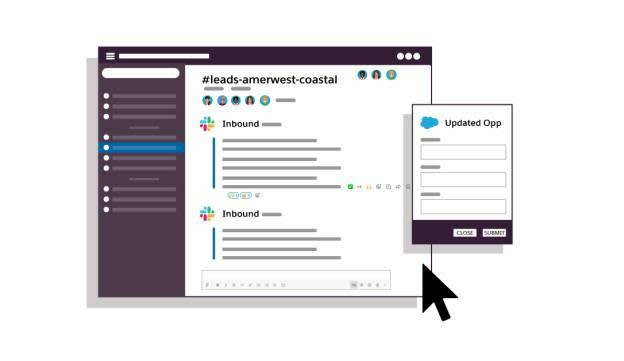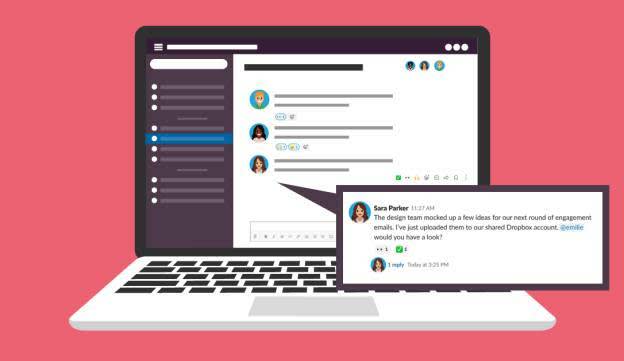See How Slack + Salesforce Can Transform Your Business
Learning Objectives
After completing this unit, you’ll be able to:
- Describe how sales, service, and marketing can benefit from the Slack + Salesforce combination.
- Provide examples of how sales, service, and marketing teams can use Slack to automate processes or integrate with external systems.
Events Make the World Go ’Round
In the last unit, you saw how Slack + Salesforce is transforming the future of work. Now let’s talk about how this transformation impacts your business. Whether you’re in sales, service, marketing, or another line of business, Slack helps power event-driven enterprise. What does that mean? Throughout the day, events happen in multiple systems: An opportunity moves from one stage to the next, an agent logs a case, or a marketer approves creative for a campaign. Slack can bring these events to your attention, keep you focused, and—through automated workflows and integrated apps and tools—help you take action quickly.
Of course, which events are meaningful and how you respond to them depends on your line of business. Sales teams need to spend more time selling and developing stronger relationships with their customers. The support organization needs to focus on solving customer problems. Marketers need to track campaign performance.
Take a look at how Slack + Salesforce helps each line of business pay attention to—and act on—events that matter.
Sales
The sales team can use the Salesforce integration in Slack to get lead notifications, scan and claim inbound leads, and log calls and meeting notes. They can listen to sales calls, create opportunities in Salesforce right from Slack, and submit updates to Salesforce records—all thanks to workflow automation in Slack. The team ensures no leads are left behind, and that every qualified lead gets a follow-up.

Another benefit of using Slack workflows to qualify and triage leads? Everyone on the sales team gets visibility to the lead pipeline. When team members share insights and updates in public channels, you increase transparency and engagement. And sales best practices are captured, documented, and searchable in the future. You also gain the added benefit of speed—sales teams can react quickly and begin working on leads right away. If you really want to get creative, you can even gamify the process by creating a leaderboard in Slack, where reps can compare stats.
Sales teams can build deeper, differentiated partnerships with customers by connecting with them securely in a Slack Connect channel. Both parties can regularly check in, exchange feedback, and update one another on progress or blockers. Product experts can instantly be added to the channel, review the history of past conversations, and address any customer questions. When it’s time to close the deal, finance and legal team members can be looped in to hash out the final details with the customer.
Sales teams can integrate Slack with external tools and systems to keep work flowing. In the past, getting customer approval might have required your reps to share and track documents manually. But with Slack workflows and integrated tools, tasks and reminders can be automated, and both the conversations and approvals can all take place via Slack.
Consider this example for how you can use integration to secure a customer’s signature.
- First, approval response notifications flow through the #sales-deal-room channel. This channel is where the sales team can collaborate with finance, legal, revenue operations, and sales operations to work on the deal.
- Next, sales reps initiate huddles with the account and legal teams to discuss the contract, go over redlines, and revise before sending to the customer. Virtually all of this process happens right in Slack, eliminating confusion and ensuring no parts of the contract fall through the cracks.
- Finally, the rep uses an integrated third-party digital signature tool to send the updated proposal to the customer for signature and approval—all within Slack.
Now let’s see how service teams can use Slack to improve the customer experience.
Service
Slack can help your customer service organization delight and wow your customers via workflow, and integrated apps and tools, including integration with Salesforce. Customer service professionals can use Slack to view Salesforce cases and volunteer where they have special knowledge, get nudges on cases that have been open for too long, or get notified when a top-severity case has been created.
Customer service teams can create dedicated channels around products, themes, and topics, and connect with cross-functional partners for collaborative case resolution. And customer service teams can collaborate on high-priority customer issues using Slack channels.

Consider this example for how you can use integration to monitor performance, manage incident response, and alert supporting teams.
- Set up a third-party integration with an online monitoring technology, and configure the necessary rules for the integration to alert in the #cx-customer-issues channel if certain criteria are met.
- A customer issue occurs; customers are unable to log in to the self-service customer support portal. The online monitoring technology detects the outage and posts an alert to the channel, notifying both engineering and the customer service team.
- The on-duty manager gets the alert and investigates the issue. They discover that a recent code change from earlier in the day had the unintended consequence of affecting some users’ ability to log in to the portal.
- The on-duty manager alerts the engineering team in the #dev-team channel. They perform a rollback of the earlier code changes. The on-duty manager keeps the customer service organization updated on the status of the resolution using the #cx-customer-issues channel.
- Once the issue is resolved, the on-duty manager posts an update in the #cx-customer-issues channel, closing the issue and providing root cause analysis (RCA).
How about the marketing team? Slack helps reduce friction and context switching, so marketers can stay focused on building and running amazing campaigns.
Marketing
When content for the latest campaign or customer journey is ready for review, an automated workflow can post requests to the appropriate Slack channel. That way, approvers get alerts and grant approvals right in Slack, to keep projects running smoothly.
And if an asset needs a minor tweak, or the approver has a quick question? Instead of crafting a lengthy email or searching on busy calendars for meeting time, team members can start a quick huddle to discuss the issue. Because huddles are audio-first, the team gets a break from being on camera, but they can still screen share when they need to review a design, slide deck, or other visual together.

Workflows can streamline things even after the team launches that big campaign. Marketers can monitor performance and automate alerts to a Slack channel when issues or anomalies arise, so representatives from marketing and engineering can investigate and engage at just the right time.
Of course, automation and workflows get even more powerful with integrated apps and tools. For example, the team can streamline social listening and responding to customer feedback, and do everything right in Slack, thanks to integrations. In the past, marketers might have used multiple social media and email campaign engagement apps to monitor customer responses to campaigns and journeys.
But take a look at what happens when you surface customer behavior and feedback in Slack.
- Add a social media app to a #mktg-customer-feedback channel, where customer comments and questions appear in real time.
- A customer replies to your latest post announcing a new feature. They love the new functionality, but they’re disappointed that a key tool no longer works the way it used to.
- The social marketing manager invites the product and engineering teams to the channel to discuss the issue. Was the change to this customer’s favorite tool planned, or is it a bug? The product manager explains that it was a planned change. Furthermore, the new feature does the work of the old tool even better.
- Armed with this knowledge, the marketing manager invites writers and graphic designers to the channel to help brainstorm a supportive response. The goal is to thank the customer for their feedback and provide illustrated tips for how to use the new feature.
- After posting the response, the marketing manager reports back to the product and engineering teams. The customer likes the tips, and has ideas for how the product can be improved in the future. The product manager adds these ideas to the development backlog.
Slack to the Future
As we look to the future, there is tremendous opportunity for Slack + Salesforce innovation. We are excited about our partners and customers building on the Slack platform, and about the possibilities ahead for bringing Salesforce platform features, like Einstein, search, and low-code development, to the Slack + Salesforce combo.
Speaking of the future, your headquarters just went virtual. Slack is the place where conversations come together, information can easily be found, collaboration is seamless, and your team’s favorite apps are connected in one place. Because when the right people are together in the same space, whether virtual or in person, they can build great things, solve problems, and dream up the next innovation. See you in Slack!